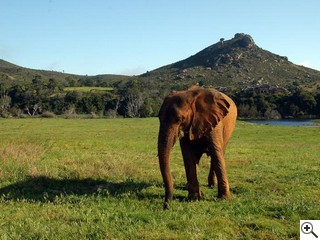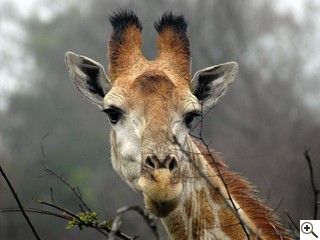


If you want to go out "hunting" for wild animals in Africa, a national park or a game reserve is possibly the best choice to see them. Using a four-wheel drive, along with a professional guide and your camera are the minimum requirements to get an amzaing experience and pictures of the Big Five game animals as well as other typical African wildlife. Prepare your best tele-lenses, and do not drink too much coffee to keep a steady hand for your action shots. During the early morning hours expect some haze, but the wild animals are already active, moving and playing around, eating and drinking.


The African elephant can be easily identified by its big ears and the impressive tusks of male and female animals. Usually found in small groups. This one is a baby elephant enjoying the savory grass.

Number four on the list of the Big Five is the lion. You should hear their immense sound of the roaring in the early morning... it sent shivers down my spine. Most of the time though they seem to be sleeping until they get hungry. Beware - action time again!

Big Number five is the leopard; unfortunately, I was not able to find one. But I have seen humpback whales mating in the bay of Hermanus. With a length of around 13 meters and 25 tons of weight, I would rate it as a fair candidate to be one of the Big Five.

Meet the fierce crocodile dundee with its V-formed snout and vicious upper and lower jaw teeth showing. Going on a photo safari could give you an adrenalin rush, especially if you meet one of those comrades face to face but I used a tele to get not too close.

The South African giraffe is a subspecies of giraffe found in South Africa. It has rounded or blotched spots, some with star-like extensions on a light tan background, running down to the hooves. I really love how they look into my camera.

The common eland or eland antelope is the second largest known antelope in the world. It can weigh up to nearly a ton. Can you imagine that they are capable of jumping up to 2.5 meters from a standing position when surprised suddenly? I got a typical South Africa adult specimen, without torso stripes.

This male ostrich is a perfect example of the largest and heaviest bird on our planet. The male, which has mostly black feathers, sits on the eggs at night, and the drab, brown female who lays up to 20 eggs, covers them during the day. In this way, the nest is much harder to see - clever birds.

The Burchell’s zebra is a southern subspecies of the Plains Zebra. The color is ochre or off-white, but never pure white. From afar, it looks like they are striped black and white, but they do have shadow stripes (more light brown). The shadow stripes (between the black stripes) are usually well marked, and the leg stripes are absent or poor, and almost never complete down to hooves.